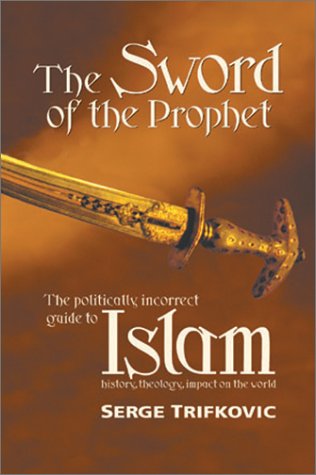'''''The Sword of the Prophet The politically incorrect guide to Islam History, Theology, Impact on the World''''' (2002) is a book by Srđa Trifković, a Serbian-American historian, journalist, and political analyst. The book chronicles events related to the rise of Islam and what Trifkovic describes as the patterns of violence adopted by its founder, Muhammad. He also documents what he sees as the historical application of jihad to non-Muslims.
Contents
*''Chapter 1 Muhammad''
In this first section the author provides an in-depth coverage of pre-Islamic history and the geo-political background to the rise of Muhammad and Islam. Trifkovic contends that
* There are no historical records on Muhammad earlier than 800 AD, two centuries after Muhammad's death.
* The Hadiths are the equivalent of urban legends crafted by the Arabs eager to mythologize Muhammad.
* There is no scientific evidence that Muhammad's tribe descended from Abraham's lineage.
* Islamic culture has a tribal mindset that stems from the Arabs' centuries of living in the desert. It is a culture that does not deem itself accountable to outside authorities or man-made laws, and which Trifkovic argues has little regard for human life. The mindset includes the raiding in packs to overwhelm lone individuals or smaller groups, the acceptability of murder of outsiders, the pillaging and robbery of their property, and a general contempt for anything but the strength of their rival tribes.
* Pre-Islamic Arabian songs suggest that women in Arabia had more rights and freedoms in the pre-Islamic era than afterwards. For instance, Trifkovic argues that women in Arabia were masters of their own bodies, owners of property, and were free to choose their husbands and divorce them if they wished.
* Early in his career, Muhammad was a camel driver for his uncle's caravan. It was during those trips that Muhammad came into contact with people who presented bits and pieces of information about the Jewish and Christian religions.
* Muhammad exhibited physical symptoms at the time of his claimed revelations that suggest he may have suffered from epilepsy and was prone to hallucinations.
* At first he was ridiculed by his own tribe for his claims of divine revelation. This angered him and in response he began a campaign of elimination and murder of anyone who challenged his claims.
* Muhammad provided divine justification to his followers for the killing of non-believers and rewarded their actions by granting them ownership of the booty taken from those they killed. He also sanctioned the rape of captive women and their enslavement along with the children who were captured.
*''Chapter 2 The Teachings''
The theology of Islam is described, including its relationship to pre-Islamic beliefs from which the author traces most of the beliefs that became part of Islam. In this section the author contends that
* The rituals that make up the five pillars of Islam were designed to separate the "hypocrites" from the faithful. Those who did not submit to the five rituals could be easily weeded out and dealt with.
* The five daily prayers are modeled on the five daily prayers of Zoroastrianism.
* Fasting during the month of Ramadan is drawn from the Jewish practice of Yom Kippur and the Sabians|Sabian month of fasting.
* The walking around the Kabaa, the kissing of the black stone, the run between two hills, the throwing of stones against a stone pillar symbolizing the devil, and the sacrificial slaughtering of animals are all pre-Islamic pagan rituals.
* Unlike the Christianity|Christian God who loves all creatures in his kingdom and allows free will, the Islamic god Allah only loves believers and rejects unbelievers, condemns them to fiery deaths, and forbids free will.
*''Chapter 3 Jihad without end''
The history of Jihad from the time of Muhammad's death to the present day.
* Muhammad inculcated his followers in the idea that his new religion should rule the world and that they should fight in Jihad until this is achieved. This idea is neither extreme nor remarkable from the point of view of traditional Islam.
* Muhammad taught a gospel of cultural erasure where new converts were expected to discard their pre-Islamic cultural roots and even their non-Arabic names. In Islam the pre-Islamic past is irrelevant and meaningless.
* Slaughter of non-Muslims marked the initial wave of conquests after Muhammad's death. The Christians in Syria were massacred in 634, between 635 and 642 in Mesopotamia Christian monasteries were ransacked and the monks and villagers slain, in Egypt towns of Behnesa , Fayum, Nikiu and Aboit were put to the sword. The inhabitants of Cilicia were enslaved. Cyprus was attacked. In 643 Tripoli was pillaged and the Jews and Christians were forced to turn over their women and children as Slavery|slaves to the Muslim army. They were told they could deduct the value of their enslaved family from the Jizya poll tax. Carthage was razed to the ground and most of its population killed.
*''Chapter 4 The fruits''
The current beliefs and practices of Muslims on such topics as Sharia, women, homosexuality, slavery, racism, anti-Semitism, and myths of a golden age.
*''Chapter 5 Western Appeasement''
Covers contemporary activities of the followers of Islam in the Balkans, Chechnya, Pakistan, Turkey, Saudi-Arabia, and Africa.
*''Chapter 6 Jihad's Fifth column''
Discusses the issues associated with Muslim immigration into non-Muslim countries.
- ISBN10 1928653111
- ISBN13 9781928653110
- Publish Date 1 June 2002
- Publish Status Active
- Publish Country US
- Imprint Regina Orthodox Press
- Format Paperback (US Trade)
- Pages 332
- Language English
